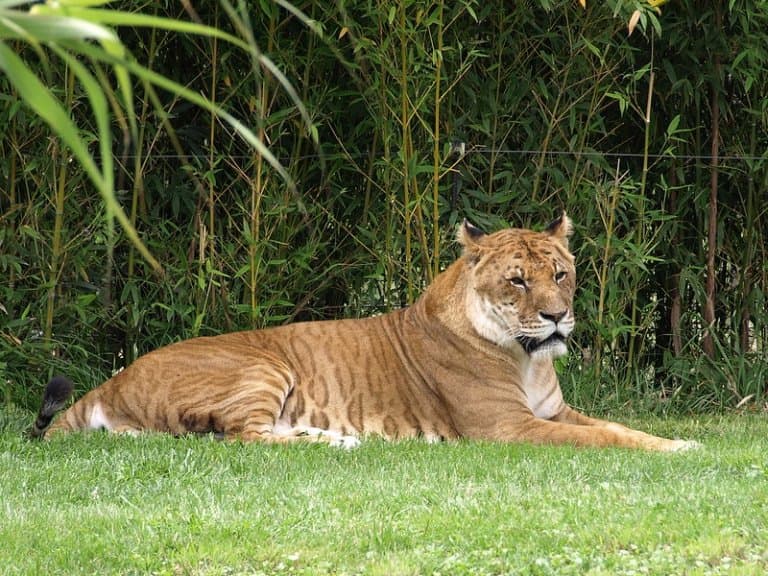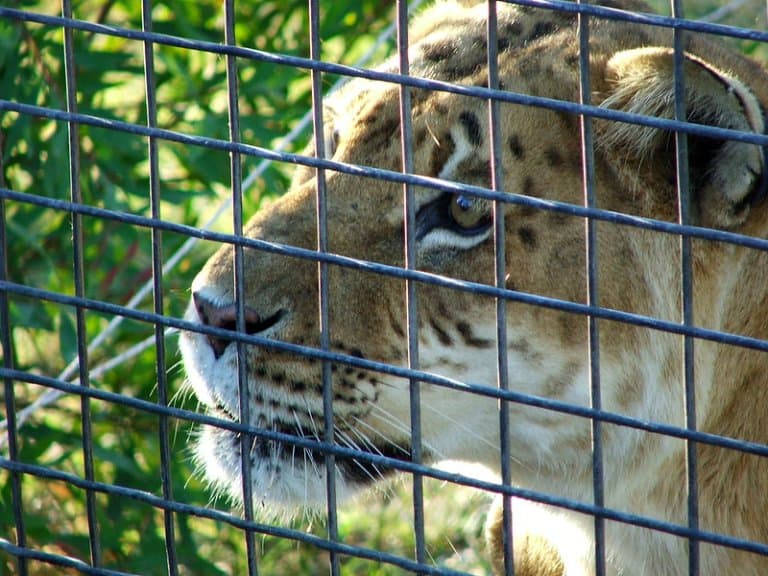Tigon Profile
The long-standing debate about who would win between a tiger and a lion has been made redundant when zoologists discovered that they’re lovers, not fighters.
We all know from Napoleon Dynamite that a Liger is a lion and a tiger mixed; bred for its skills and magic. But what happens when a tiger and a lion mix?
Strangely enough, that produces something different. A smaller animal with less magic and fewer skills, but still well worth knowing!
A tigon, also known as a tiglon, or tion is a hybrid of a male tiger and a female lion. They have characteristics of both parents, with faint spots from the lion, and stripes from the tiger.

Tigon Facts Overview
| Habitat: | Only in captivity |
| Location: | Zoos in at least nine countries |
| Lifespan: | Unknown |
| Size: | Around 1m (3ft) tall |
| Weight: | 180 kg (3,976 lb) |
| Color: | Striped, golden brown/orange |
| Diet: | Meat |
| Predators: | None |
| Top Speed: | Unknown |
| No. of Species: |
Undefined |
| Conservation Status: |
Not listed |
A liger is the product of a male lion and a tigress. When the roles are reversed, what pops out is a Tigon. The two are distinctly different, and not all that well known.
It’s likely there are no more than 100 tigons in existence, all products of captive animals whose natural habitats would never overlap.
Tigons carry growth inhibitors which mean they don’t grow any larger than their parents, and are often smaller than a lion in size. The average tigon measures between 4 – 9 ft long and weighs around 90 – 160kg (200 – 350lb). A male tigon won’t have a full mane of hair like a lion, but will retain some ruff. There coloring is somewhere between a lion and a tiger.
While tigons can lead relatively normal lives, unfortunately they have a heightened risk of suffering from a number of neurological and physical conditions and their lifespan is often much shorter.
While thought to be extremely rare, it is possible that historically lions and tigers may have interbred to produce tigons in the wild, although this is controversial. The Asiatic lion once inhabited a much larger area of Asia, that may have meant it shared some territory with tigers.
Interesting Tigon Facts
1. They’re not natural
“For fun” is not a commonly accepted justification for a breeding program in AZA-accredited zoos, but the nature of the beast is that unregulated experimentation occurs all over the world for dubious reasons, primarily: money.
The “appeal to nature” argument, while popular, is a logical fallacy: plenty of things that are natural are terribly dangerous and disgusting (e.g., cholera, Andrew Tate), and plenty of unnatural things are great (e.g., houses, shoes).
But in this instance, the unnatural quality of this animal is a direct problem. Tigers and lions are separated by over 6 million years of evolution, so their genes have had a long time to become very different.
As such, while they’re close enough genetically to produce offspring when brought, this unholy spawn is not something that would ever show up in the wild, and is lacking in a lot of basic adaptation and biological functions. 1

2. They’re not healthy
Lion/tiger hybrids, in both directions, are often poorly-made. They have neurological conditions, are usually sterile, have a predisposition to cancers and have a significantly diminished life expectancy than their parent species.
Most tigons don’t survive infancy for these reasons, and those who do have a very poor quality of life. Not only are these animals unhealthy by design, but they’re also kept entirely in captivity for no valuable reason.
The majority of the reasons they exist relate to a curiosity for paying visitors, as they serve no ecological role and very little if anything is gained by science in hybridising them in uncontrolled experiments.
3. Litigons and Titigons
While mostly sterile, there are some accounts of female tigons reproducing. In 1972, in India, a tigon female gave birth to offspring sired by an Asiatic lion. The result was called a Litigon. This animal grew to 362kg.
An African lion sired two more in China in 2017, prompting further debate around the scientific value and ethics of such breeding.
In 1978, in California, a female tigon and a male tiger were kept together in an enclosure, with the belief that the female was sterile.
This resulted in a surprise pregnancy, after which a titigon was born. It’s reported that this male titigon died from cancer at nine years old, both he and the mother dying from cancer. 2
4. They inherit growth-inhibitory genes from both parents
While the ideal tigon is a grand beast with a lion’s mane and tiger stripes, the reality is that for every good-looking example, there are countless who died at birth, during infancy, or didn’t make it through pregnancy in the first place.
There is some debate over whether tigons suffer dwarfism, and while it’s believed they don’t, they do inherit growth-inhibitory genes from both parents and are usually smaller than a lion in size.
5. Frankencats
While trade, handling and veterinary care are all important factors to regulate, there’s a distinct lack of regulation when it comes to breeding captive animals, most notably in the US, where vast proportions of the captive inbred or hybrid big cats are still found.
There are likely more tigers in captivity in the US than are left in the wild, and many activists are trying to push for better protections that would cover unethical breeding programs that only serve to generate income.
The major problem comes from the demand for the practice, as many visitors express an interest in seeing ligers and tigons and don’t know anything about the suffering involved in their creation.
Activists want both stricter regulations on breeding from the USDA, and better education among visitors to address this practice from both ends of the supply chain.
6. There may be some potential merit to these programs
With the new arrival of these hybrid animals, researchers are looking into the common attitudes of revulsion to such practices. While there is clearly an ethical dilemma in breeding animals to produce what will inevitably be unhealthy offspring, there may be some value to the information gleaned from controlled experiments.
Defining species is tricky enough, as life, the universe and everything exist on a spectrum that doesn’t adhere to our categorical nature. Trying to find the line between one lineage of animals and another brings us a deeper understanding of how species evolve and what keeps them separate.
As with everything scientific, it’s important to identify a bias of disgust towards research, and if the major objections in hybrid programs are emotional ones relying on the naturalistic fallacy, then we have to look for better justifications for restricting them.
That said, the ethical argument against breeding sick animals for show is a valid one, and whether the greater contribution to science justifies this unkind act remains open for debate. 3
7. Tigons are banned in Taiwan!
Taiwan has imposed a ban on the crossbreeding of lions and tigers to produce hybrid cats like tigons and ligers.
In contrast, there are many other countries that still haven’t banned crossbreeding.
These include China, Iran, United Arab Emirates, The United States of America, Argentina, India, Russia and the Czech Republic.
Tigon Fact-File Summary
Scientific Classification
| Kingdom: | Animalia |
| Phylum: | Chordata |
| Class: | Mammalia |
| Order: | Carnivora |
| Family: | Felidae |
| Genus: | Panthera |
| Species Name: |
Panthera Tigris ♂ × Panthera Leo ♀ |
Fact Sources & References
- Oliver Milman (2017), “Ligers and tigons: activists aim to outlaw ‘inhumane’ breeding of frankencats“, The Guardian.
- Shubhobroto Ghosh, Piyali Chattopadhyay Sinha & Anindya Sinha (2017), “The litigon rediscovered“, Nature.com.
- Jani Hall (2017), “Cat Experts: Ligers and Other Designer Hybrids Pointless and Unethical“, National Geographic.
